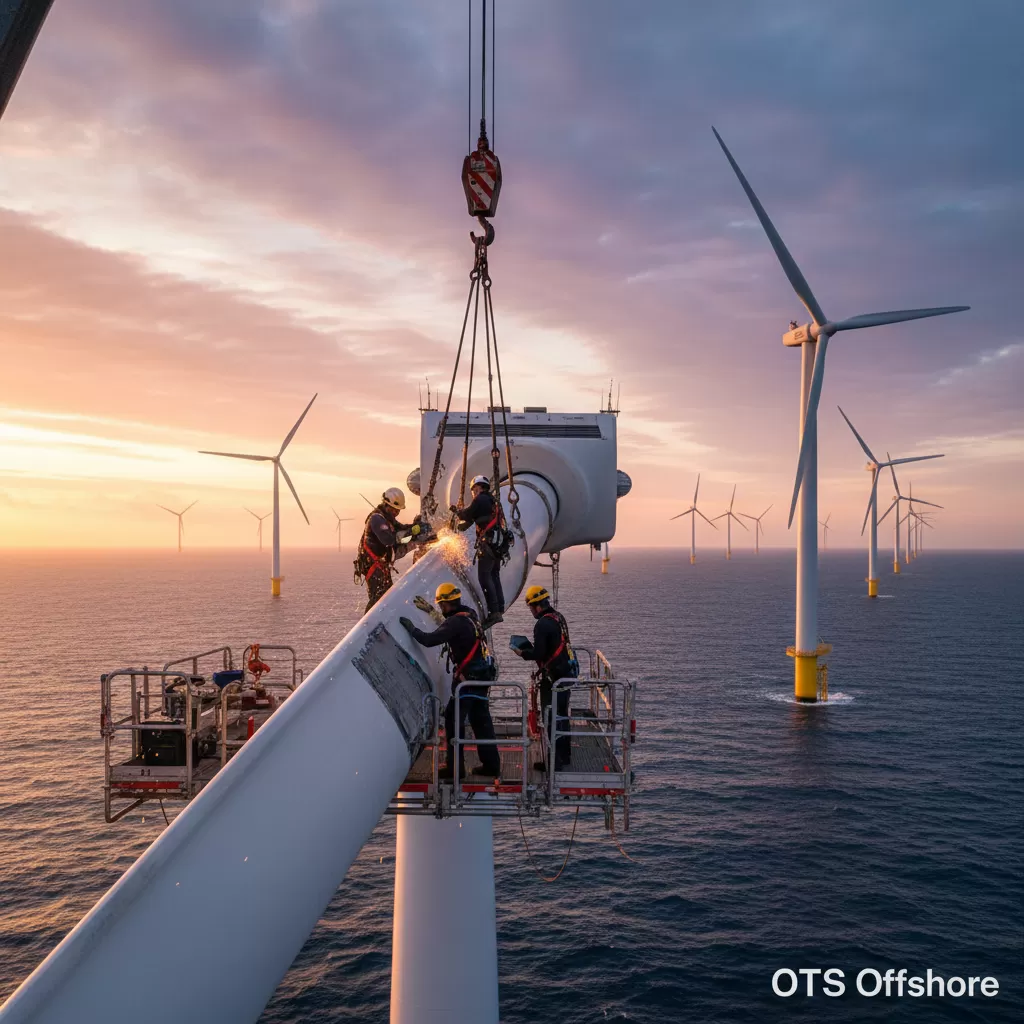The Importance of Blade Repair and Wind Turbine Maintenance Stages is critical for ensuring the longevity, efficiency, and safety of wind energy assets. This article delves into the core aspects of wind turbine blade maintenance, emphasizing proactive repair strategies and the comprehensive stages involved in effective upkeep, ultimately contributing to sustained renewable energy production and operational excellence.
Understanding the Importance of Blade Repair in Wind Turbine Lifecycles
The Importance of Blade Repair transcends simple cosmetic fixes; it is a fundamental pillar of operational integrity and economic viability within the wind energy sector. Wind turbine blades, exposed to relentless environmental stressors and mechanical loads, are susceptible to degradation. Ignoring or delaying essential blade repairs can lead to a cascade of detrimental effects, significantly impacting energy output, increasing operational costs, and posing serious safety risks. Proactive and timely blade maintenance, including meticulous repair processes, is not merely a cost center but a strategic investment in the asset’s long-term performance and the reliability of renewable energy generation. This section will explore why the Importance of Blade Repair is paramount for the sustained success of wind farms globally.
The aerodynamic surfaces of wind turbine blades are intricate engineering marvels designed for optimal energy capture. However, their continuous exposure to elements like high winds, rain, hail, UV radiation, and atmospheric pollutants inevitably leads to wear and tear. This degradation manifests in various forms, from minor surface erosion and coating damage to more severe structural issues such as delamination and fatigue cracks. Each of these imperfections, regardless of its initial severity, can disrupt the smooth airflow over the blade’s surface, leading to reduced aerodynamic efficiency. This reduction directly translates to lower power output, a critical concern for any wind farm operator aiming to meet generation targets and secure revenue streams.
Furthermore, neglected blade damage can escalate rapidly. A small crack, initially inconsequential, can propagate under cyclical stress, potentially leading to catastrophic failure. The consequences of such a failure are multifaceted and severe. Firstly, it necessitates costly emergency repairs and significant downtime, halting energy production and incurring substantial financial losses. Secondly, blade fragments can cause extensive damage to other turbine components, including the tower and nacelle, amplifying repair expenses. Most critically, a catastrophic blade failure poses a significant safety hazard to personnel on-site and to the surrounding environment. Therefore, the Importance of Blade Repair lies in its preventative capacity, averting these costly and dangerous scenarios.
The economic imperative for prioritizing blade repair is also undeniable. Modern wind turbines represent a significant capital investment. To maximize the return on this investment, operators must ensure these assets function at peak performance for their entire operational lifespan, typically 20 to 25 years, and often longer with proper care. Regular inspections and prompt repairs of blade defects are essential for maintaining this performance. By addressing minor issues before they become major problems, operators can avoid expensive component replacements, minimize unplanned downtime, and optimize the overall levelized cost of energy (LCOE). This focus on the Importance of Blade Repair is a cornerstone of efficient wind farm management.
Beyond the immediate operational and economic benefits, a robust blade maintenance program, including effective repair strategies, contributes to the overall sustainability of the wind energy sector. A well-maintained turbine is a reliable source of clean energy. Conversely, poorly maintained turbines can lead to increased operational inefficiencies and a perception of unreliability, potentially hindering the broader adoption of renewable energy technologies. In essence, the Importance of Blade Repair is intrinsically linked to the credibility and advancement of the entire wind power industry.
The Critical Stages of Wind Turbine Blade Maintenance
Effective wind turbine blade maintenance is not a singular event but a structured, multi-stage process designed to identify, assess, and rectify any deviations from optimal performance and structural integrity. This systematic approach ensures that potential issues are addressed early, preventing minor problems from escalating into costly failures. Each stage plays a pivotal role in extending the operational life of the blades, maximizing energy generation, and ensuring the safety of the wind turbine and its surrounding environment. Understanding these stages is fundamental to appreciating the full scope of the Importance of Blade Repair.
1. Pre-emptive Inspection and Monitoring
This initial phase is the bedrock of proactive maintenance. It involves a combination of routine visual inspections, advanced diagnostic technologies, and continuous monitoring systems. The goal is to detect any signs of wear, damage, or deviation from the expected operational parameters as early as possible.
– Visual Inspections: Carried out by trained technicians, these inspections involve close examination of the blade surfaces, leading edges, trailing edges, and tip areas. Technicians look for visible signs of erosion, cracking, delamination, lightning strikes, foreign object damage (FOD), and coating degradation. Inspections can be performed from the ground using binoculars or drones, or up close via rope access or working platforms for more detailed assessment.
– Drone-based Inspections: Unmanned Aerial Vehicles (UAVs) equipped with high-resolution cameras, thermal imaging sensors, and even ultrasonic testing equipment are increasingly used for blade inspections. Drones offer a safe, efficient, and cost-effective way to survey large numbers of blades and access difficult-to-reach areas, providing detailed imagery for analysis.
– Blade Condition Monitoring Systems (BCMS): Advanced BCMS utilize sensors embedded within the blades or installed on the turbine to continuously monitor parameters such as vibration levels, strain, temperature, and acoustic emissions. Deviations from baseline readings can indicate developing structural issues, allowing for early intervention.
– Performance Monitoring: Analyzing turbine operational data, including power output, pitch angles, and rotational speeds, can reveal aerodynamic inefficiencies that may stem from blade damage. Subtle drops in performance can be an early indicator of blade degradation.
The insights gained from this stage are crucial for determining the necessity and scope of subsequent repair work. Early detection significantly amplifies the Importance of Blade Repair by allowing for less invasive and more economical interventions.
2. Damage Assessment and Diagnosis
Once potential issues are identified during the inspection phase, a thorough assessment and diagnosis are required to understand the nature, extent, and root cause of the damage. This stage dictates the appropriate repair strategy and resource allocation.
– Detailed Examination: Based on initial findings, technicians may conduct more in-depth examinations using specialized equipment. This could involve using endoscopes to inspect internal structures, ultrasonic testing to detect subsurface cracks or delaminations, or eddy current testing for metallic components.
– Root Cause Analysis: It is vital to understand why the damage occurred. Was it due to aerodynamic erosion, lightning strikes, manufacturing defects, environmental factors, or operational stress? Identifying the root cause is essential for implementing effective long-term solutions and preventing recurrence. For instance, if leading-edge erosion is prevalent across a fleet, it might indicate a need for improved leading-edge protection or a different material specification.
– Classification of Damage: Damage is typically classified based on its severity and type. Minor surface damage might be categorized as requiring a simple coating repair, while significant structural damage like delamination or deep cracks would necessitate more complex composite repair procedures.
– Reporting and Recommendation: A comprehensive report detailing the findings, the assessed severity of the damage, and recommended repair solutions is generated. This report forms the basis for decision-making regarding the repair plan.
This diagnostic stage directly informs the Importance of Blade Repair by ensuring that the chosen repair methods are appropriate and effective for the specific problem encountered.
3. Repair Planning and Material Selection
With a clear diagnosis in hand, the next step involves meticulous planning of the repair process and selecting the appropriate materials. This stage is critical for ensuring the long-term effectiveness and structural integrity of the repaired blade.
– Defining Repair Scope: The plan outlines the exact procedures, the specific areas to be repaired, the sequence of operations, and the estimated time and resources required. For complex repairs, detailed engineering drawings and specifications may be necessary.
– Material Selection: Choosing the right materials is paramount. For composite blade repairs, this often involves selecting specific types of epoxy resins, fiberglass fabrics, carbon fiber reinforcements, and fillers that are compatible with the existing blade material and capable of withstanding operational stresses and environmental conditions. The choice of materials directly impacts the strength, durability, and aerodynamic performance of the repaired section.
– Environmental Considerations: Repair work must often be performed under specific environmental conditions, such as controlled temperature and humidity. Planning must account for weather windows, especially for repairs conducted at height.
– Safety Protocols: Comprehensive safety plans are developed, detailing necessary personal protective equipment (PPE), working at height procedures, scaffolding requirements, and emergency response protocols.
– Resource Allocation: This includes scheduling qualified technicians, securing necessary equipment, and managing logistical support for transporting materials and personnel to the turbine site.
Effective planning ensures that the repair is conducted efficiently, safely, and with the highest likelihood of success, reinforcing the Importance of Blade Repair as a well-orchestrated process.
4. Repair Execution
This is the hands-on phase where the actual repair work is carried out by skilled technicians. Precision and adherence to the planned procedures are vital for a successful outcome.
– Surface Preparation: This is a crucial preliminary step. It involves cleaning the damaged area, removing any loose material, sanding, and ensuring a smooth, well-prepared surface for bonding new materials. Proper surface preparation is critical for the adhesion of repair materials.
– Composite Repair: For structural damage, this typically involves applying layers of fiberglass or carbon fiber pre-impregnated with resin (pre-preg) or wet lay-up techniques, followed by curing under controlled conditions. This process restores the structural integrity of the blade.
– Leading-Edge Protection: Repairing or applying new leading-edge protection systems (e.g., erosion tapes, coatings) is a common task to combat aerodynamic erosion. These systems are designed to withstand the impact of rain, hail, and sand.
– Filling and Fairing: Minor surface imperfections, such as small cracks or dents, are filled with specialized epoxy fillers and then faired to restore the original aerodynamic profile of the blade.
– Painting and Finishing: Once the structural repairs are complete and cured, the blade is typically painted with specialized coatings that provide UV protection, moisture resistance, and contribute to aerodynamic smoothness. Color matching and finish quality are important for both performance and aesthetics.
– Quality Control Checks: Throughout the execution phase, quality control checks are performed to ensure that each step is completed correctly and according to specifications.
The meticulous execution of repairs is the direct realization of the Importance of Blade Repair, transforming damaged components back to optimal functional status.
5. Post-Repair Verification and Monitoring
After the repair is completed, a verification process is essential to confirm that the repair has been successful and that the blade is performing as expected. Continuous monitoring thereafter ensures the longevity of the repair.
– Visual Inspection: A final visual inspection is conducted to ensure the repair is seamless, properly finished, and free from any defects.
– Non-Destructive Testing (NDT): Depending on the nature of the repair, NDT methods like ultrasonic testing might be employed again to verify the integrity of the repaired composite structure and ensure good bonding.
– Performance Analysis: Turbine performance data is closely monitored post-repair to confirm that energy output has returned to expected levels and that there are no new anomalies.
– Ongoing Monitoring: Blades that have undergone significant repair may be placed under a more rigorous monitoring schedule. This could involve more frequent drone inspections or enhanced data logging from BCMS.
– Warranty and Documentation: Proper documentation of the repair process, materials used, and verification results is crucial for warranty purposes and future maintenance records. This information aids in understanding the long-term performance of repaired blades.
This final stage closes the loop in the maintenance cycle, ensuring that the Importance of Blade Repair is not only addressed but also validated, securing the continued reliable operation of the wind turbine. The integration of these stages forms a robust framework for managing the health of wind turbine blades, underscoring why the Importance of Blade Repair is a cornerstone of sustainable wind energy.








